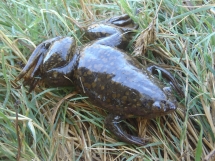Overview
This research focuses on determining the effects of a non-native amphibian, the African Clawed frog (Xenopus laevis), on the native ecosystem. Little is known about how these elusive frogs will affect native species but they have the potential to inflict serious ecological harm.
Currently, there has been little research into how these feral populations may be impacting native amphibian populations. Xenopus have spread throughout watersheds in southern Californi (Lannoo, M. 2005) and their invasion has correlated with the decline of many native amphibian populations. My research will explore three aspects of how these non-native frogs may be affecting native amphibians by: spreading the amphibian fungus, Batrachochytrium dendrobatidis (chytrid); preying upon native species; and altering native amphibian behavior.
Origin
The African Clawed frog, shipped around the world beginning in the 1940’s for pregnancy tests and later used for other research purposes and in the pet trade, has escaped the confines of captivity and established wild populations in non-native ranges (Tinsely and Kobel, 1996). Currently there are populations confirmed in the South America (Lobos and Jaksic, 2005), Europe (Faraone et. al, 2005; Measey, 2001) and the United States (McCoid and Fritts, 1980), in California and Arizona.
Introduction
Levels of Chytrid in the Environment
Xenopus may act as a reservoir for chytrid fungus, spreading it to the native amphibians as they enter the water body that Xenopus has invaded. Chytrid is known to be the cause of many native amphibian population crashes worldwide (Skerrat et. al, 2007) and many California frog and toad species have experiences severe population crashes due to this fungus.
By comparing the concentration of chytrid on native amphibians in areas with high and low densities of Xenopus, the effect of the presence of Xenopus on the abundance of chytrid in the environment can be determined.
Changes in Native Amphibian Behavior
Adult Amphibian Avoidance
There is evidence that native amphibians avoid breeding in areas where Xenopus have invaded (Lillo et. al, 2011). If this is the case, it may reduce the amount of suitable habitat available to native amphibians that have already experiences significant habitat loss.
Changes in Tadpole Behavior
Tadpoles are sensitive to the presence of predators in the environment, reducing their foraging activity when they sense the presence of a predator (Feminella and Hawkins, 1994; Petranka and Hayes, 1998). This has been shown to reduce the size and likelihood of survival of the larvae into adulthood (Skelly ad Werner, 1990).
Ecological Effects
These frogs are capable of reaching high densities where they may alter invertebrate populations and may also feed on tadpoles of native amphibian species.

